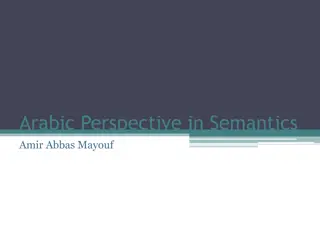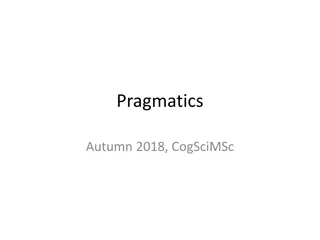Theories and Concepts in Semantics: Classical vs. Prototype Approaches
Explore different theories of concepts in semantics, including classical theories based on necessary and sufficient conditions, causal theories, and prototype theories. Compare their strengths and limitations in handling fuzziness, asymmetry, and internal structure of concepts. Discover how experimental evidence supports the idea of prototypes as central to conceptual understanding.
Download Presentation

Please find below an Image/Link to download the presentation.
The content on the website is provided AS IS for your information and personal use only. It may not be sold, licensed, or shared on other websites without obtaining consent from the author.If you encounter any issues during the download, it is possible that the publisher has removed the file from their server.
You are allowed to download the files provided on this website for personal or commercial use, subject to the condition that they are used lawfully. All files are the property of their respective owners.
The content on the website is provided AS IS for your information and personal use only. It may not be sold, licensed, or shared on other websites without obtaining consent from the author.
E N D
Presentation Transcript
LIN1180 Semantics Lecture 5 Albert Gatt
Theories of concepts I: Necessary and sufficient conditions We considered the pros and cons of the classical theory of concepts: Necessary and sufficient conditions MAN = [human, adult, male,...] No fuzziness: Some entity x is either an instance of concept C or not Semantics -- LIN 1180
Theories of concepts II: The causal theory (Putnam, Kripke) Causal theory states that proper names identify individuals because of some initial event in which the connection is set up Others receive the name and use it, even if they don t know what caused the association Some argue that nouns that denote natural kinds work the same way. E.g. GOLD Someone must have discovered it and called it gold An expert would know exactly what it takes for a substance to qualify as gold We don t need to know, we simply use the term because of the original christening Semantics -- LIN 1180
Some characteristics of these theories Both theories have little to say about fuzziness. They can t really handle asymmetry: If x and y are both instances of a concept, then they are equally good instances Semantics -- LIN 1180
Theories of concepts III: prototypes Extensively studied by psychologist Eleanor Rosch in the 1970 s. Central argument is that concepts have internal structure, with some members being better than others. Example: BIRD: central/typical members (sparrow) have features typically associated with the concept (flies, has wings, has feathers ) peripheral members (ostrich, penguin) There is a gradient from centre to periphery Semantics -- LIN 1180
Prototype example Semantics -- LIN 1180
Evidence I: Goodness of exemplar Experimental subjects are shown pictures of different things of the same category (e.g. VEGETABLE) Asked to rate each one in terms of how good an example of the category they are. E.g. carrot, turnip, cabbage, beetroot, lemon Subjects tend to be quite homogeneous in agreeing on what typical and not-so-typical members are. (As long as they come from the same cultural group) Semantics -- LIN 1180
Evidence II: Prototype effects Order of mention: Under time pressure, when asked to list members of a category, subjects tend to list the prototypical members first. Acquisition: prototypical members tend to be acquired first. Learning: kids learn new words faster if taught the meaning with reference to the prototype. Reaction time: People judge statements of the form X is a Y if X is typical of Y than if it isn t. Similarity ratings: Less representative examples are more similar to more representative examples of a concept, than vice versa Mexico is more similar to the US than the US is to Mexico An ostrich is more similar to a sparrow than a sparrow is to an ostrich Semantics -- LIN 1180
Evidence III Generalisation: We tend to generalise easily from typical/representative to non- typical examples. If a disease affects robins (typical), it could well affect ducks (atypical) But not so much the other way round If a disease affects ducks (atypical), we find it less likely for it to affect robins Family resemblances: Remember Wittgenstein on the concept of GAME? Rosch s experiments show that people often categorise objects in terms of similarity to some typical member of a category. FOOTBALL is a typical/salient instance of SPORT HANDBALLis less typical, but has some similarities to FOOTBALL Semantics -- LIN 1180
Consequences of prototypes Views concepts as having fuzzy boundaries some things might qualify as CHAIR, but they might not be typical some things qualify as RED, but others are between RED and PURPLE Semantics -- LIN 1180
In the remainder of this lecture We ask: What is the relationship between culture, language and thought? We contrast two theoretical stances: universalism relativity Semantics -- LIN 1180
Questions to think about Are languages simply vehicles for a common, universal vocabulary of concepts, or do different languages embody different worldviews? Can you think of words or expressions in your native language that would be untranslatable into another language? Semantics -- LIN 1180
Part 1 Universalism vs. relativism
Whats the relationship between concepts, language and thought? Strong Universalist view: The way we think is completely independent of language. Therefore, thought and concepts are largely independent of linguistic differences. Strong relativist view: Relativism: Language reflects the culture in which it is spoken. Cultural differences result in linguistic differences. Determinism: Language determines our way of thinking. Linguistic differences, reflecting cultural differences, result in differences in ways of thinking and conceptualising the world. Semantics -- LIN 1180
A potted history of relativism (I) Herder (18th Century philosopher) The human spirit thinks with words Talking is thinking aloud Language and thought are one and the same; different languages reflect different ways of thinking Humboldt (19th Century) Each language contains a characteristic worldview So languages do display different perspectives on the world. Semantics -- LIN 1180
A potted history of relativism (II) Edward Sapir viewed language as part of culture, shaping us and our world views and thoughts: The fact of the matter is that the 'real world' is to a large extent unconsciously built up on the language habits of the group . . . . We see and hear and otherwise experience very largely as we do because the language habits of our community predispose certain choices of interpretation. (Sapir 1929) Sapir s student Benjamin Lee Whorf took this further: We cut nature up, organise it into concepts because we are party to an agreement that holds through our speech community and is codified in our language (Whorf, 1956) Semantics -- LIN 1180
Whorfs relativism The Linguistic Relativity hypothesis suggests that language, culture and thought are closely interlinked. This is largely reflected in the semantic structure of language. Whorf paid particular attention to how differences in grammar give rise to different ways of thinking. Semantics -- LIN 1180
Time: an example from Whorf Whorf compared the conception of time in English and Hopi (American Indian). English conceptualises recurrent phases like ordinary objects. E.g.: we speak of 10days as we do of 10 men Hopi has no equivalent of 10days [sic]. English: They stayed 10 days. Hopi: They stayed until the 11th day. English objectifies time in terms of units; Hopi conceptualises time in terms of a stretch. Semantics -- LIN 1180
Time in English In English, time is a formless substance which is divided into phases, periods etc. use of nouns for stretches of time (seasons etc): this summer; it is a hot summer time is a substance, contained in these phases spatial metaphors for time: long, short, quick, slow Whorf suggested that this leads to an objectifying tendency in the way we think of abstractions like time . Semantics -- LIN 1180
Time in Hopi Hopi does not use nouns for phases. Most expressions are adverbials. emphasis on the relation between earlier and later and while The Hopi word for morning would be translated as while morning-phase is occurring. less tendency to use spatial metaphors more tendency to view time as a factor influencing things as they age or change less tendency to identify events as single, individual occurrences Whorf suggested that this leads to more emphasis on the subjective passing of time. Semantics -- LIN 1180
A potted history of universalism (I) Plato wondered how people knew so much when their contact with the world was so brief and limited There must be something common to all humans. To Plato, all knowledge is universal and innate. The same view was adopted by Descartes in the 18th Century. This is the core of Chomsky s definition of Plato s problem. Since the 1950s, Chomsky has promoted the view that much of our linguistic knowledge is innate and universal. Semantics -- LIN 1180
A potted history of universalism (II) Philosopher and cognitive scientist Jerry Fodor has defended the universalist view Language of thought hypothesis (Fodor, 1975): thought is independent of natural language it has its own metalanguage , which is universal, a kind of mentalese , which is innate therefore, the same structures of thought and meaning underlie all languages More recently, Fodor (1998) has argued that all concepts must be innate. Do you think the concept AEROPLANE or PTERANADON is something you re born with? Semantics -- LIN 1180
Why does this matter? It seems obvious that languages differ in the concepts they encode as words. Equally obvious is the idea that a people will have developed words that are most useful in their environment. At the same time, people in different cultures seem to have a lot in common, biologically and psychologically. We would expect all languages to have words for food, drink, air, person Semantics -- LIN 1180
More recent positions Semanticists have tried to identify core semantic universals across languages: Basic vocabularies Universal principles of organisation The less extreme view is that there is a lot which is shared, a core vocabulary of concepts . There is also a lot which is not shared, because it depends on culture and environment. But what is not shared can be defined in terms of the core vocabulary. This is the position advocated by Anna Wierzbicka, who has tried to identify cross- linguistic differences in word-meaning, but insists that they can all be explicated using a core, universal conceptual vocabulary. Semantics -- LIN 1180
What concepts should we look at? Researchers have investigated the relationship between language and culture by focussing on core concepts basic perceptual categories (e.g. colour and shape) abstract mathematical concepts (e.g. number, quantifiers) Semantics -- LIN 1180
Part 2 Contemporary research: Studies of colour terms
The logic behind it Question: If a language can t distinguish a colour, will its speakers fail to perceive it? Reasoning: 1.assume all humans have the same basic physiological capacity to perceive things 2.suppose language L1 has no word for RED 3.suppose speakers of L1 fail to perceive red 4.then, if speakers of L1 cannot perceive RED, it must be because their language has a causal influence on their perception Semantics -- LIN 1180
Berlin and Kay (1969) Classic cross-linguistic study of colour terms. B & K compared several languages from unrelated families The question: is there a universal underlying pattern beneath colour terms cross-linguistically? B&K s answer: yes there is! Semantics -- LIN 1180
Basic colour terms B&K focused on basic terms, i.e. terms which: are monolexemic (e.g. black is ok; reddish-brown is not) are not hyponyms of other terms (e.g. red is basic, but scarlet is a hyponym of red) are widely applicable (e.g. yellow, but not blonde) are not extensions of something manifesting the colour (e.g. gold and faun are excluded) Semantics -- LIN 1180
Some cross-linguistic examples Dani (New Guinea): only two terms, one meaning broadly light, the other dark Pomo (Ca, USA): three terms Tamil (India): 6 terms Lebanese Arabic, English: 10/11 terms Semantics -- LIN 1180
So what? B&K argued that the differences hide a fixed universal pattern. a universal division of the colour spectrum into discrete categories Main claim: there are a few basic categories of colour terms categories are ordered in a hierarchy if a language has one category, it will also have categories lower down this is an implicational universal Semantics -- LIN 1180
The Berlin and Kay hierarchy Dani (New Guinea): only black or white white/black red green/yellow blue brown purple/pink/orange/grey 1. Pomo (Hokan): black/white + red 2. Ibibio (Niger-Congo): black/ white + red + green 3. 4. Tzeltal (Mayan) Tamil (Dravidian, India) 5. 6. English, etc. Semantics -- LIN 1180
B&Ks claims If a language has a system at a certain level, that system includes the systems below it. e.g. Pomo has red, therefore it has black and white The hierarchy reflects a historical developmental process: English must have gone through the black/white, red, etc stages before reaching its current state Implication: all speakers of all languages are capable of perceiving all colours (contra the strong relativist claim) languages will develop more complex systems over time Semantics -- LIN 1180
Empirical validation Eleanor Rosch tested the B&K theory on speakers of Dani compared to English speakers: Dani only has the black/white system Q: can they still perceive other colours and distinguish them? If so, then language does not determine our perception, at least for colour Result: in spite of linguistic differences, Dani and English speakers showed the same pattern of errors in colour perception Rosch concluded that colour concepts are universal, but some languages have lexicalised fewer of these Semantics -- LIN 1180
More recent challenges Sampson (2005) noted serious methodological flaws in the Berlin and Kay study e.g. the data was collected from texts, by students with no knowledge of the languages some of the results have since been questioned Davidoff (2001): new psychological studies on Berinmo speakers (New Guinea) these people divide the colour spectrum differently from English speakers division is according to their linguistic system e.g. their notion of blue includes some shades of purple and green, which English speakers distinguish and have different words for, whereas Berinmo don t seem to. Semantics -- LIN 1180
Summary: the colour term debate The original claims by Berlin and Kay seemed reasonable, but: the studies may have suffered from methodological flaws the jury is still out on whether colour perception is universal and independent on language Semantics -- LIN 1180
Part 3 Contemporary research: Numerical cognition
The number sense Rationale: 1. Suppose language L2 only distinguishes quantities in a very basic way e.g. one vs. many Then, we can ask whether speakers of L2 are capable of abstract quantitative reasoning like other speakers. 2. If not, then there must be an influence of language over mathematical cognition. 3. Semantics -- LIN 1180
Peter Gordons work Gordon (2004): investigated these questions among the Piraha tribe in the Amazon Piraha distinguishes one , two and many . No terms for twenty , thirty-three No recursive devices for forming complex numbers ( one hundred and one etc) Semantics -- LIN 1180
Some observations on Piraha The three words for one , two and many are used as prototypes: h i ( one ): typically for one objects, but often also used for a few ho ( two ): typically for 2 objects, but also for a relatively small quantity greater than h i aibaagi( many ): for any number of objects which are a lot Semantics -- LIN 1180
Experimental task (example) 7 participants in a matching task Experimenter sits opposite participant places a linear array of objects on a table participant has to match the array with his own objects (a kind of substitute for counting) Semantics -- LIN 1180
Matching task: results If the array consisted of between 1 and 3 objects, participants were reasonably accurate. With greater numbers, performance became increasingly inaccurate. Tendency became more pronounced with more complicated versions of the task. Semantics -- LIN 1180
Gordons conclusions The results of these studies show that the Piraha s impoverished counting system limits their ability to enumerate exact quantities when set sizes exceed two or three items. (2004, p. 498) Semantics -- LIN 1180
Some reflections on Gordon (2004) Gordon s study was restricted to a small set of individuals. Not very controlled environment. It has sparked off a considerable debate about: whether all languages are equal whether language has a conditioning effect on thought: Can we not think things which we cannot name? Semantics -- LIN 1180
Some reflections on Gordon (2004) Gordon s work goes beyond words: languages like English have simple number words (one, two ) but also grammatical systems which allow these words to be combined (one hundred and one .) If Gordon s observations are correct, then grammar may have a role to play in thinking: grammar may be a way of combining simple concepts into complex ones. Semantics -- LIN 1180
Next lecture We have now taken a tour of some of the theories and debates surrounding concepts and representation. We begin a more in-depth investigation of: definitions of a word word meaning word senses Semantics -- LIN 1180























